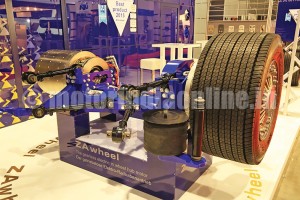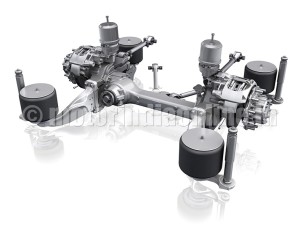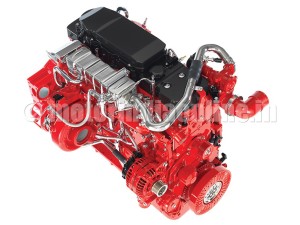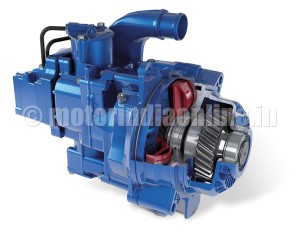Busworld Kortrijk, the biennial event held in Belgium, is undoubtedly the most preferred platform when it comes to showcasing the latest products and technologies for the global bus and coach industry. While our November edition presented a complete Busworld show report, we bring you in this article four of the most exciting emerging technologies in the global bus and coach market, all displayed at this year’s edition of Busworld.
The wheel hub drive is one of the concepts to electrify buses. Instead of having a motor and coupling with gear box and driving wheels through axles, the other option is to drive wheels directly by coupling the motors to it. This option is best suited for retro fitment for diesel buses. This was demonstrated by Ziehl-Abegg of Germany.
Fleet operators also showed interest in electric retrofitting of conventionally powered city buses (diesel, gas). In this context the companies are looking for a single project planner and conversion partner. Ziehl-Abegg meets this requirement from two aspects: any standard bus 10.5 and 12 to 18 metres in length can be easily converted into an electric bus with ZAwheel by being retrofitted with the new ZAaxle drivetrain module. In addition, in Benteler Engineering Services (Munich), there is another company that offers an all-round, worry-free retrofitting: package from system analysis and/or design to conversion; even the type approval is offered at Benteler on a ‘one-stop shopping basis’.
Public Utilities Department in Germany commissioned five electric buses into operation as part of the ZeEUS Project. The Department has installed quick charge stations at its depot as well as at the two bus termini. These stations use the quick charge process to recharge batteries on the roof of vehicles during the normal scheduled waiting period. Referring to the battery reserve even if there is no time to charge the battery, e.g., because of delays, the bus can continue operating. Thanks to the charging stations being located at the termini and the efficient ZAwheel drive, the dimensions of the batteries have been kept to a minimum. In fact, the vehicle weighs hardly any more than a conventional bus.
The gearless in wheel hub drive from Ziehl-Abegg is now fitted as standard by several European bus manufacturers like VDL Bus & Coach (The Netherlands), Hybricon Bus Systems (Sweden), Ekova Electric (the Czech Republic), Troliga (Slovakia), Lider Trading (Poland) and ebe Europe (Germany)
Low-floor bus axle
The requirements of modern public transport systems are on the increase. Currently they encompass extensive eco-friendliness and higher comfort, lower cycle times and BRT concepts as well as a more efficient operation with higher passenger volumes at the same time. High-performance technology is needed to ensure that the means of transport are able to meet these requirements. A city bus chassis enabling a very low floor and a consistently level passenger area are the basic prerequisites in this context. Because of this and of many other sought-after features, ZF established the AV/AVN 132 model range which has become the most successful low-floor rear axle for city buses. ZF is trying to replicate this success story with the technically optimized successor AV 133 that is likely to enter volume production in 2016.
Even the AV 133 basic version scores with integrated functions for panels and screw connections. Compared to the predecessor system, it offers higher performance with unchanged installation dimensions. Nevertheless, its weight is no more than 983 kg, including its spring carriers made of spheroidal cast iron, air springs, dampers and control arms.
Furthermore, ZF developed optional lightweight spring carriers made of aluminum for the AV 133, lowering the axle weight by another 45 kg, i.e., five per cent. In this way, the low-floor portal axle compensates for a large part of the additional vehicle weight that is and/or will be generated by the additional components required for the new emission standards or for driveline electrification.
For efficiency and acoustics reasons, the ZF engineers placed further emphasis on the portal drive and the oil supply. They improved the surface stress of the bevel gearsets and extended their diameter by 10 millimetres. Similarly, the portal gearing for the AV 133 was optimized with regard to noise emissions and stability and got a newly-designed input gear. A look into the inside of the axle differential discloses an advanced bearing concept and an improved lubricating system.
With these effective detailed measures, the AV 133 will surely attract attention in public transport operation: The noise level is up to three decibel lower than with the current AV 132, which feels like half of the loudness level. The low-floor bus axle is filled with a special, semi-synthetic lubricant at the plant that extends the AV 133 oil change intervals from 180 000 to 240 000 km.
Start-stop system for diesel engines
Stop-start systems have been available as part of diesel-electric hybrid bus technology for some time. However, the high investment cost has prevented many operators from justifying the investment and achieving savings without subsidies. Cummins has developed a system that delivers 4-7 per cent fuel savings without significant operator investment and meets the durability requirements of city bus duty cycles. A vehicle could stop every minute, so to meet the tough operational needs Cummins has redesigned critical engine components and validating them across 4 million stop-starts cycles.
Cummins has made a significant level of hardware updates to the ISB Euro 6 engines to make the technology successful. These include a new starter motor capable of 210,000 start-stop events, a new flywheel and ring gear, new wiring, a new engine speed sensor, an updated fuel system, new con rod bearings and new crankshaft bearings. These as well as the current engine parts have all been validated during the test cell and field test program covering both buses and truck installations. The ISB engine software has been upgraded to manage the technology and provide flexible architecture, enabling customers to choose what they want from it and tailor it to their operations.
Additional benefits seen from stop-start include passenger and pedestrian comfort with reduced noise and vibration on the bus when it stops as well as reduced emissions around bus-stops.
Secondary water retarder
Voith showcased a water-based retarder – the Aquatarder that is an energy-efficient, resource-sparing component for buses and coaches. The Voith Aquatarder SWR is the first secondary retarder to brake with water, using the cooling agent of the engine for the process. This means that it does not need an additional operating medium and is able to perform up to 90 per cent of all vehicle braking operations wear-free.
In addition, it requires only half the installation space compared with its predecessor and is 35 kg lighter. It uses engine water cooling as an operating medium and therefore does not require regular oil change. This ensures less stress on the drivelines and longer life of components. The main advantages are they are maintenance free, high endurance braking power and high availability. It’s also leant that the endurance braking power of the retarder is upto 520kW / 700hp. This is fitted in the Evo bus range of both Mercedes Benz and Setra Coaches by integrating into Proximity Control Assist and Active Brake Assist. Like any other retarder this is also hand lever and foot pedal controlled. This also has constant speed function for downward descent.



